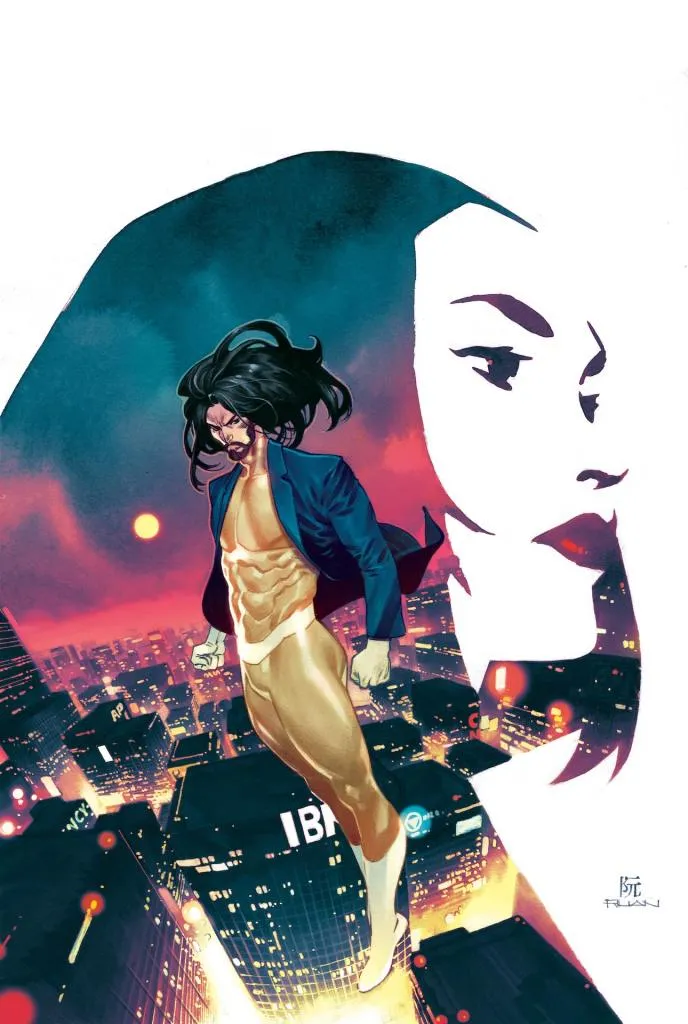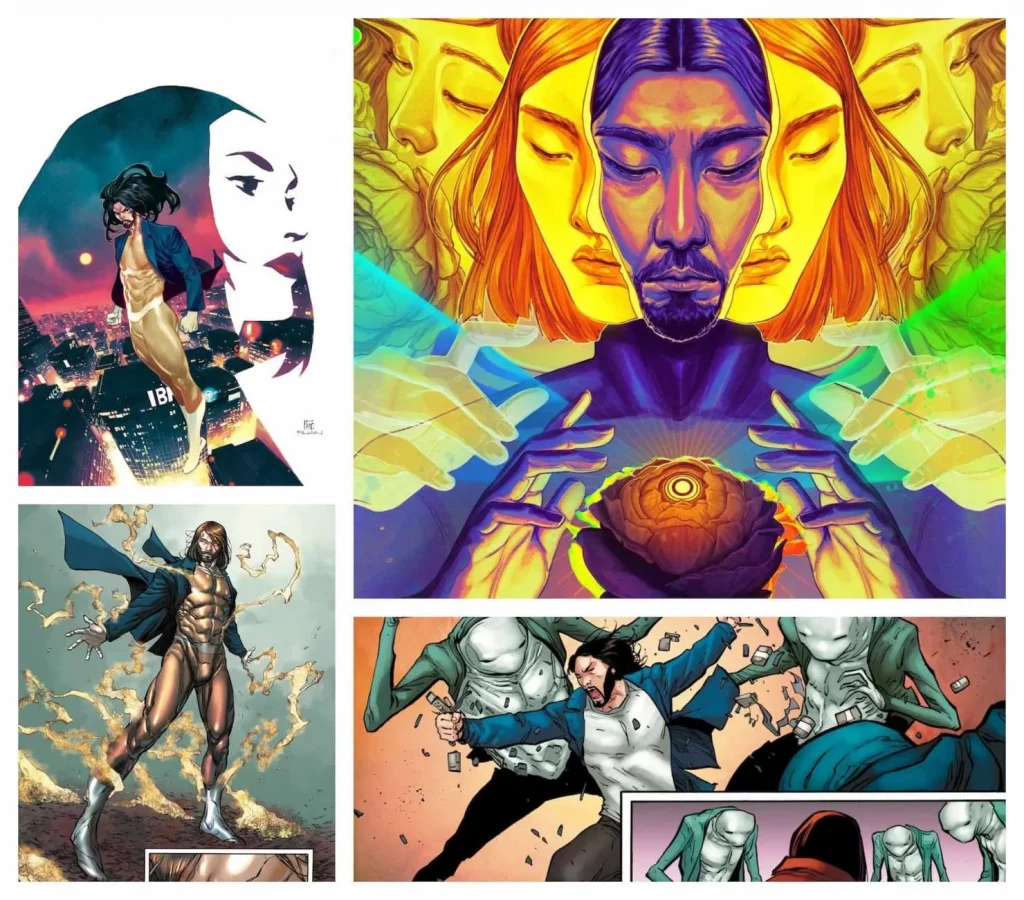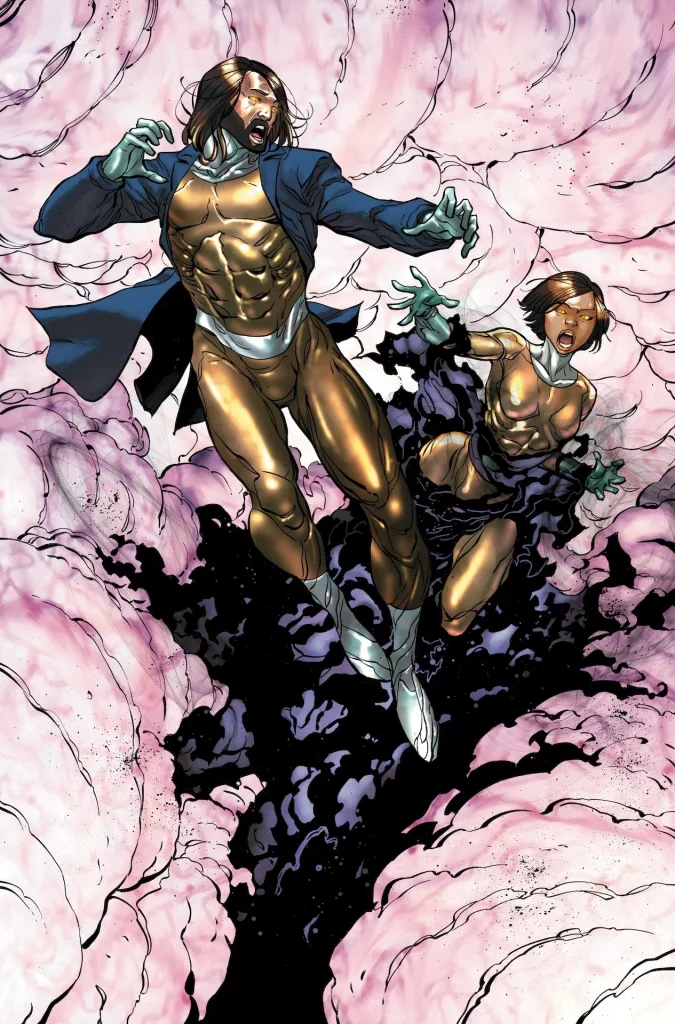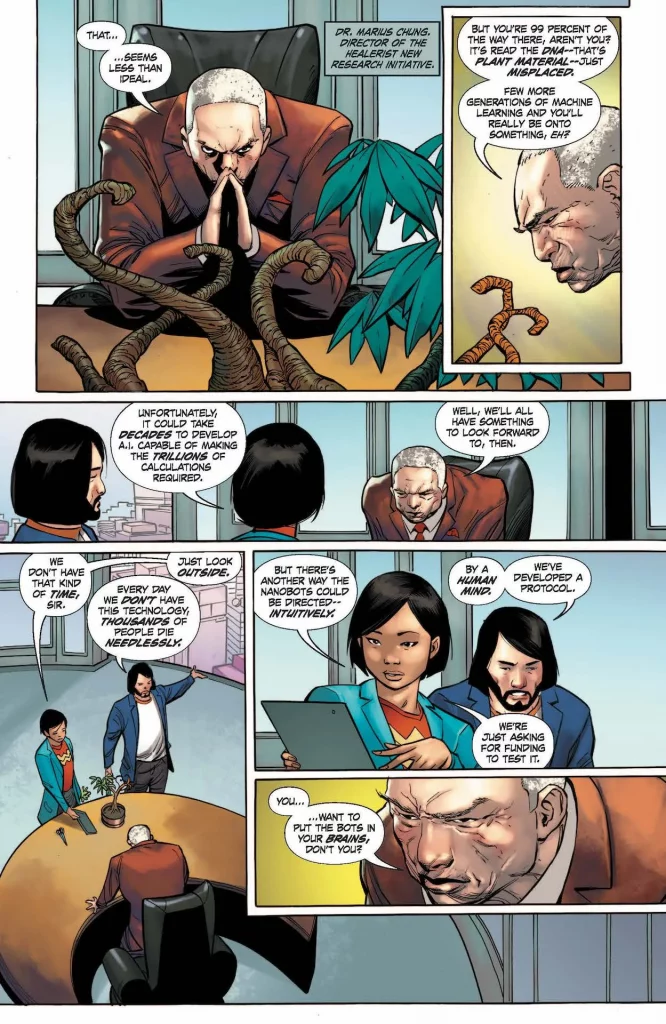Talking ‘Duo’, new Milestone stories with Greg Pak, Khoi Pham, and Scott Hanna
The tales of Earth-M kick off this May.
David Brooke | AIPT
On May 17, the Milestone Comics universe expands with Duo by Greg Pak, Khoi Pham, Scott Hanna, Chris Sotomayor, and Janice Chiang. The new six-issue series is set in a brand-new version of Earth called, conveniently enough, Earth-M. This earth will feature an entire roster of all-new superheroes, and it all starts with Duo.
The story follows two nanotech engineers, Dr. Kelly Vu and Dr. David Kim, who also happen to be lovers. After a terrible accident, the pair are fused together (think sort of like Firestorm), at which point they use their superhero abilities to save the world. It actually harkens back to Milestone’s early days and a character called Xombi originally created by John Rozum and Denys Cowan.
Before issue #1 arrives (and just in time for the FOC of April 24), we caught up with Pak, Pham, and Hanna about the project. We also dug into how the story began some five years ago, the value of Asian American representation in comics, and much, much more.
AIPT: Greg, Reggie Hudlin pitched the idea for Duo to you. When you first heard about this project, where did your mind wander surrounding the idea of having this romantic partner duo forever inside one mind?
Greg Pak: Yeah, it was immediately interesting. Reggie and Denys [Cowan] had come up with this updating and re-imagining of the Xombi concept from back in the day. The big idea was through this nanobot technology that saves one person, you end up getting both people in one person’s mind. Which was just great. Kind of what I do is the big loopy genre, storytelling. And that’s just fun because sci-fi fantasy genres, all kinds, I just love. But in order to tell a story that matters, I need to have an emotional hook, and this was a huge emotional hook that was gonna be endlessly fun to explore.
AIPT: What’s it like working with Denys Cowen and Reggie Hudlin?
GP: It was great. They came in with the big high concept ideas and then kind of cut us loose to build what we could build. So then those outlines and ideas got tossed in and we’d have some discussions and then they gave the thumbs up. I mean I think they brought us all on board because they like what we do. That’s the best position to be in, to be with people who wanna work with you cause of what you do. And then what they’re giving you to work with is the kind of stuff you like to do.
AIPT: What was your relationship with Milestone Comics when it was launched in the ’90s?
Scott Hanna: It was actually a really cool project that we’re getting. Anytime for me, when you can start creating brand new characters, the universe of DC or whatever is just fun. I’ve only done it a couple of times. Duo is actually pretty much only the second time I’ve been in from the ground floor of new characters, new series, you get to invent new bad guys. Milestone took that in a wonderful direction. I worked with Denys Cowen before, not on any of the mainstream Milestone books at that time, and that was a nice breath of fresh air. It’s great to see 20 years later that these characters are on TV, they’re integrated into all the other stuff that’s out there. So I’m hoping that our stuff on Duo will be at some point in the not-to-distant future integrated into, you know, what we see in other media or just part of the universe. I think of us as being kind of self-sustained in our original story, but it allows for a lot of integration with everything else.
Khoi Pham: Now that you’re asking this question David, it actually triggered an emotional memory. When given the opportunity to join Milestone, that was a hard yes. Now that you’ve jogged my memory I remember now I was in high school and I was introducing comics to my younger cousins. They were all excited and Milestone came out and they went to the comic store and just bought all the Milestone books to share with me. So that’s a really great memory of spending time with my cousins and getting them to get into comics. So Milestone was how they said, “Hey, this is something new have you seen this?” And I hadn’t. So that was kind of neat for them to share back with me.
So I guess deep-seated in there was this like, “Yes!” I wanna do Milestone, but, but then when Greg approached about that world creating and character building and we can tell our story. Who would say no to this?
GP: I went through a couple of waves of reading comics and not reading superhero comics. Sadly I was not reading a lot of superhero comics when Milestone first hit. When I found out about it and subsequently met the heroes behind it all, like the real-life heroes, and what those comics did and the fight that they fought and continue to fight for just getting all kinds of people up on the page is near and dear to my heart. So it’s a huge honor to be part of it.
AIPT: Duo is also set in Earth-M which is fascinating. What was the starting material for this world before you kicked it off with your scripting and drawing?
GP: We just started writing and they were like, “okay, good.” So I guess that’s the way that came together.
AIPT: No notes!
GP: <laugh> There are some efforts at one point to tie in more closely to some of the other books, but then the sort of editorial plan changed a little bit and we’re not tying in quite so directly with certain characters.
KP: Which can happen over five years.
GP: Yes, exactly. <laugh>.
KP: It’s been a journey.
AIPT: Since it’s been a five-year journey. Have you guys had the first issue done and completed for a while?
GP: Pretty much. I mean <laugh> It was wild. I don’t know if you guys felt the same way. It was a trip coming back to it because in comics I’m so used to like writing something, turning it in, and then literally sometimes literally like within days I’m getting layouts, you know what I mean? Then it’s out in stores within a couple of months. To have something you wrote, you know, four or five years ago…
AIPT: Pre-pandemic!
GP: Exactly. I had to look at this whole thing again and be like, “What was I saying? And is that still what I wanna say? And what does this mean anymore?” One really kind of cool thing was that we got the chance to sort of look at the whole thing and go back and make some choices about stuff earlier on.
I finagled an extra two pages to better introduce the whole story. There’s a lot of comic book science and stuff to set up in this book. This book is really about these two characters. We need a little more time with them at the very beginning of the book. It was really a gift in a way that the book got delayed for so long that sometimes having that chance to have a little more perspective gives you the opportunity this can make everything better.
SH: The fact that we’ve had this story going on for five years of our creating it, in my mind, it still holds up really well. That means for us, it’s already like dealt with the test of time. It still works five years later. That means, “Hey, we’re doing something right here.” So I’m actually really excited to see what the fan’s reaction is. When I see the pages from Chris [Sotomayor], he’s just doing a phenomenal job with the coloring. When we added those extra couple of pages of issue 1, that just set it up that little bit better, you know? In my entire career, I’ve never had this amount of time on a project. Not even close.
GP: I mean, it’s even longer compared to say traditional book publishing, you know what I mean? Letterer Janice Chiang is also doing amazing work. It is complicated because there are inner voices and figuring out like different balloon styles for different inner voices of different characters and there’s a lot going on. And she’s nailing it.
[To Khoi] Do you feel like your style changed since you drew the first pages of this?
KP: It has. It has, but at the same time, it’s nice to go back to what I did then. Right? Every five-year chunk, five years ago was a little more innocent time, right? It was actually a really fun experience getting back on the book.
AIPT: Duo also has good representation, we’ve got Kelly and David who are Vietnamese-American and Korean American characters. Will there be any exploration with their families in this to further explore?
GP: There’s a very small bit. This is really about the two of them. We don’t really get into the family as much in this particular project. I’m Asian American, I’ve written a ton of Asian American characters and family dynamic actually is a big thing that I do return to a lot in different stories. But this one isn’t really that. I think that’s cool, you know what I mean?
Not every Asian American story needs to be about first-second generation conflicts and all that kind of stuff. There’s a tiny taste of that I think in issue two. But this is really about a mature couple struggling with questions of love. That kind of story is a little rarer for specifically Asian American projects. I’m all for more, more and more and more variety. So the fact that this does something a little different is a thrill to me.
SH: Are we allowed to talk about some of the diversity of the villains that you’re setting up?
GP: <laugh> Well, you get a little tease, in issue one.
KP: To bring this back to Greg’s point on Asianness. I don’t want people to lose the sense that this is a freaking awesome superhero story. Yeah, they’re Asians, but there are cultural vehicles and that’s cool. This is not one of them. You get as much Asian as you get that Ben Grimm is a Jewish American. The extent of it is it’s a cool superior story and it’s visually representative, right?
GP: There are always layers to it. Sometimes stories, which I’ve written and love, are very much grappling right upfront with very specific “Asian American issues.” Here these characters to me are Asian American characters and they’re living Asian American lives. For those with eyes to see, there’s subtext and there’s context and the way they come from, I think that will relate to different people differently. That’s not the forefront of the story, but I think it’s still there as subtext in a way.
I will say one thing that I like too though, is that this is also a rarity in that it’s got a multiethnic couple within the Asian American community. I mean, you’ve got a Korean American and a Vietnamese American who are lovers in this story which is an incredibly common kind of thing that doesn’t get represented a whole lot.
Courtesy of DC Comics.
AIPT: Duo is also a superhero story where he gets his powers from a kind of accident. I wanted to ask you guys, do you have a favorite superhero who got their powers from an accident?
GP: Oh, wow. Well, the Hulk of course is my favorite superhero. It’s perfect. He goes running out to save somebody and then he gets cursed, you know? That sort of bitter irony is a beautiful thing in storytelling.
SH: I could be wrong, but one of the first accidental heroes, as I remember is the Flash and he’s just in the lab and gets hit by lightning and all this stuff spills on him, you know? So yeah, he wasn’t trying to save anybody, but it was definitely an accident.
GP: Kelly’s really the active one in this particular scenario. She’s the one who makes the choice, the heroic choice, that backfires on her.
KP: I personally don’t like the accident stories. They stress me out. <laugh> yeah. So they all stress me out like, oh, man, that stinks for them.
GP: <laugh> Storytelling, man. I don’t know if I can really read these things. It’s really stressful.
AIPT: There are some really creepy creatures in the first issue. There’s a cool superhero suit. What has been the most fun to draw and ink?
KP: The great thing about this is I get where Greg’s coming from in terms of representation. It’s not as simple as let’s just draw this dude with big muscles, whatever, we design characters and Greg was telling me, “Hey let’s keep body dysmorphia issues on our minds.” So we don’t accidentally depict certain bodies as being good and certain bodies as being bad. I like that very cerebral part of designing the characters. It’s fun considering all of those things in terms of how can we do more good in the world? That’s the extent of my enjoyment.
Otherwise, I hand it off to Scott and then to Chris to provide the colors. I don’t come up with the color scheme. That’s a collaboration that I enjoy watching, but from my side, I really wanna make sure it’s responsible characters. Even the villains are responsible. That’s what I like to design. I like simplicity mostly because I gotta keep drawing it over and over. <laugh>
SH: The villains that Khoi has designed are just so cool and again, different shapes, different sizes. I love the fact that he gives me room to play with textures with these characters. One guy’s got a shiny suit, one guy has a very rough and worn outfit. You know, that diversity of texture and look makes my job so much fun. We’re known for doing the main characters, the heroes, but the villains are usually where you get to have the most fun.
AIPT: When the first issue comes out on May 17th what are you hoping fans get out of that first experience?
GP: I just hope they enjoy it, you know? Storytelling in general is weird. You never know how something’s gonna go, you know what I mean? Sometimes your best work, nobody really says much, sometimes the work was okay. You did the best you could under the circumstances you had, but it’s not necessarily the stuff you’re the most proud of. And sometimes that’s the stuff that just shoots through the roof. There’s so much about timing and just hitting the right button at the right time.
SH: I’m actually very proud of the work we’ve done on this. I hope they’re as happy with it as we have been working on it.
For even more on this series, be sure to check out Pak, Khoi, and Scott’s interview about the series on dccomics.com.








